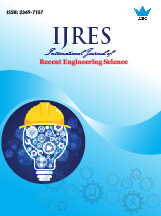Vibration Analysis of a Horizontal Washing Machine, Part II: Isolation Efficiency
 |
International Journal of Recent Engineering Science (IJRES) |  |
| © 2015 by IJRES Journal | ||
| Volume-2 Issue-5 |
||
| Year of Publication : 2015 | ||
| Authors : Galal Ali Hassaan |
||
| DOI : 10.14445/23497157/IJRES-V2I5P102 |
How to Cite?
Galal Ali Hassaan, "Vibration Analysis of a Horizontal Washing Machine, Part II: Isolation Efficiency," International Journal of Recent Engineering Science, vol. 2, no. 5, pp. 8-11, 2015. Crossref, https://doi.org/10.14445/23497157/IJRES-V2I5P102
Abstract
The objective of this paper is to investigate the transmissibility and isolation efficiency encountered with the suspension of a horizontal washing machine. This analysis aims at reducing vibration and noise excited by the rotating unbalance during the spinning cycle of the washing machine. Through parametric analysis of the drum vibration of the washing machine, the detailed effect of the drum mass, suspension stiffness and suspension damping coefficient, it is possible to examine the variation of the transmissibility and isolation efficiency with the spinning speed of the machine. The isolation efficiency is presented for spinning speed from 600 to 1200 rev/min. It is possible through proper selection of the washing machine parameters to increase the isolation efficiency to about 96 %.
Keywords
Horizontal washing machines, Vibration dynamics during spinning, Parametric analysis, Isolators efficiency
Reference
[1] E. Papadopoulos and I. Papadimitriou, Modeling, design and control of a portable washing machine during the spinning cycle, Proceedings of the IEEE/ASME International Conference on Advanced Intelligent Mechatronics, Como, Italy, 8-11 July 2001, 899-904.
[2] Z. Yanging, W. Zhiyan and Z. Yiqi, An active control strategy of vibration attenuation system based on nonlinear coupling, IEEE International Symposium on Industrial Electronics , 1, 9-11 June 2003, 448-453.
[3] C. Hansen, X. Qiu, G. Barvault, G. Howard, P. Peterson and S. Singh, Optimization af active and semi-active noise and vibration control systems, 14th International Congress on Sound and Vibration, Cairns, Australia, 9-12 July 2007, 30 pages.
[4] A. Kowalyshyn and I. Kwolkoski, Case study: Mitigation of excessive vibration induced by commercial washers on elevated post-tensional concrete slab, , Noise Conference, Dearborn, Michigan, 28-30 July 2008, 12 pages.
[5] F. Tyan, C. Chao and S. Tu, Modeling and vibration control of a drum type washing machine via MR fluid dampers, Proceedings of CACS International Automatic Control Conference, Taipei, Taiwan, 27-29 November 2009, 7 pages.
[6] T. Nygards and V. Berbyuk, Pareto optimization of a washing machine suspension system, 2 nd International Conference on Engineering Optimization, Lisbon, Portugal, 6-9 September 2010, 11 pages.
[7] P. Boyraz and M. Gunduz, Dynamic modeling of a horizontal washing machine and optimization of vibration characteristics using genetic algorithms, Mechatronics, 23(6), 2013, 581-593.
[8] C. Mukherje and A. Bhardwaj, A study of vibration control methods for front loaded washing machines , International Journal of Recent Technologies in Mechanical and Electrical Engineering, 1(2), September 2014, 47-48.
[9] X. Ma, F. Hu and J. Liu, Dynamic characteristic simulation of drum washing machine rigid-flexible coupling model, International Journal of Control and Automation, 8(5), 2015, 167-176.
[10] G. A. Hassaan, Vibration analysis of a horizontal washing machine, Part I: Vibration displacement and velocity, International Journal of Engineering and Advanced Research Technology, 3(4), 2015, under publication.
[11] A. Yorukoglu and E. Altug, “Determining the mass and angular position of the unbalanced load in horizontal washing m,achiness”, IEEE / ASME International Conference on Advanced Intelligent Mechatronics, Singapore, 14-17 July 2009, pp.118-123.
[12] S. Solhar and D. Patel, “Optimization of a drum type washing machine by analytical and computational assessment”, International Journal of Scientific and Engineering Research, vol.4, issue 6, 2013, pp.2759-2763.
[13] P. Antonio, Predicting isolation efficiency using mobilities, www.hallani.com, January 2010, 13 pages.
